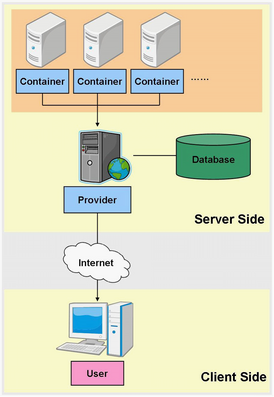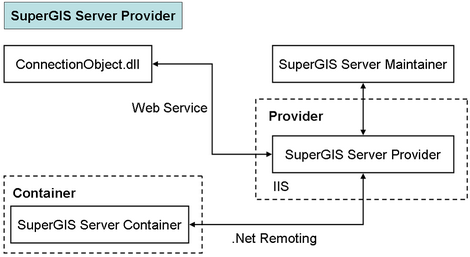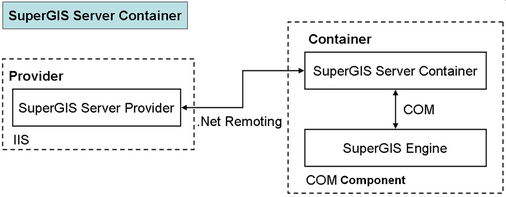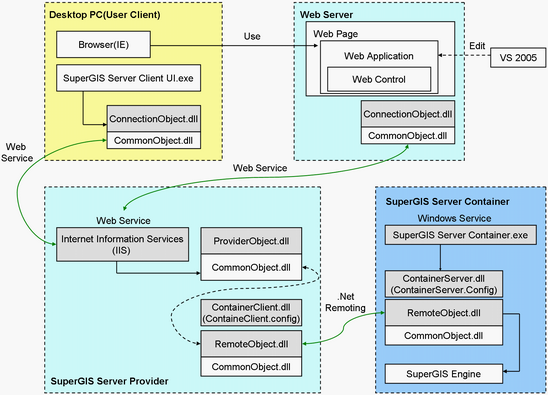The Operating Architecture of SuperGIS Server
SuperGIS Server is a set of enterprise server class software publishing various geographic information services. It can be divided into Client Side and Server Side. After users install SuperGIS Server Desktop Client for client side, the front end software, SuperGIS Desktop, can be used to connect to SuperGIS Server over Internet or Intranet. The licensed geographic information services therefore can be used just like used in local host side.
Two server objects should be installed to server side of SuperGIS Server, SuperGIS Provider and SuperGIS Container. The server side is basically composed of one set of Provider and several Containers. The Provider plays the role as the manager to set up the various Containers in back end. Users do not have to know the real locations of the back end Containers or how they work. As long as users connect to the specified Provider, they can obtain the Internet services provided by the Provider and the powerful operation sources of the back end.
The front end applications and objects (such as SuperGIS Desktop, SuperGIS Engine, SuperPad, SuperGIS Mobile Engine and Web Control) that support SuperGIS Server can send request of Web Service through the user side object of SuperGIS Server (ConnectionObject.dll) to the remote Provider (SuperGIS Server Provider), and the result processed by Provider can be received through the object, too, such as the Provider image or data.
Provider can be viewed as the bridge of communication and data transmission between the client side and back end Container. Provider transfers the services or data through Client side Server connection object (ConnectionObject.dll) in the form of Web Service and communicates with the numerous back end Containers in the form of .Net Remoting. Generally, Provider side has a Provider maintenance program (SuperGIS Server Maintainer), and through the Provider managing object users can read or write in the service properties that are published by Provider. Of course, if data is allowed to be accessed with permission in Provider, SuperGIS Server Maintainer will also be able to be installed to client side, and the Service properties of Provider are able to be accessed through remote connection.
Container is the object which can be built on many machines, supplying computing resources to tackle the huge and complex computing demand transferred fromProvider. In the form of Component Object Model (COM), Container processes and accomplishes the related tasks through SuperGIS Engine of the bottom tier object of local host. Generally speaking, Container and Provider are placed on different machines but in the same Internet environment. Through Intranet the front end user's demand is fast processed and the result will be returned to the Provider. At last the result is sent back to the user end by Provider and displayed in the form of Web Service.
The Web Service environment built by SuperGIS Server can be divided into four parts, User Client, Web Server, SuperGIS Server Provider and SuperGIS Server Container.
User Client can get the required Web Services from SuperGIS Server through the general browser or the front end software object of SuperGIS Server. Different from the front end application software, before users want to access the Web Services through browser, a Web Server Website should be built up as the medium to offer the related Web Control and SuperGIS Server connection object so the services published by SuperGIS Server can be obtained. When Provider side receives the user request, if the request takes computing, for example Provider uses the real-time mapping mechanism instead of Image Cache, Provider will communicate with the back end Containers and get the result in the form of .Net Remoting. At last the result will be returned to the Web server or displayed in the front end application software.
©2017 Supergeo Technologies Inc. |





